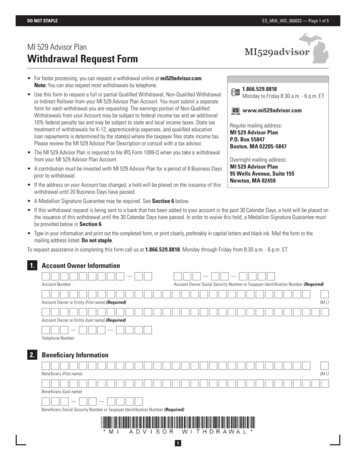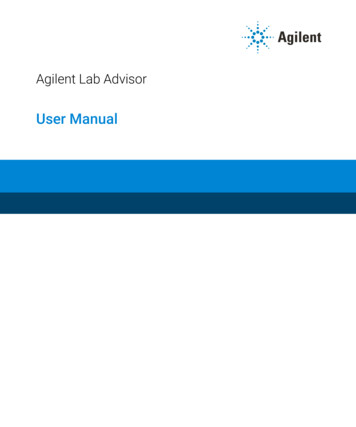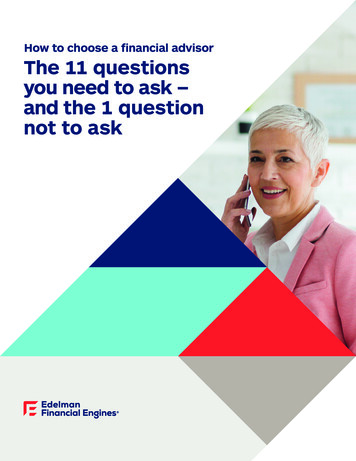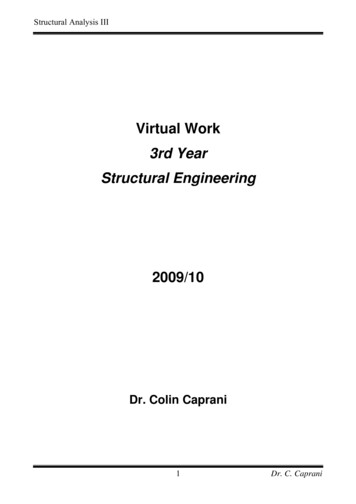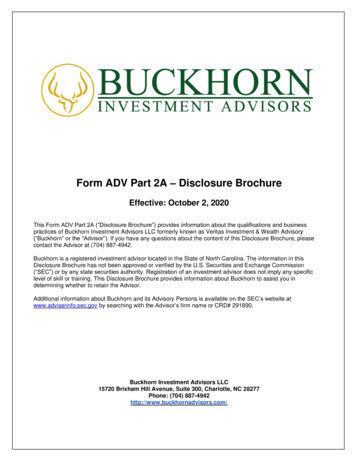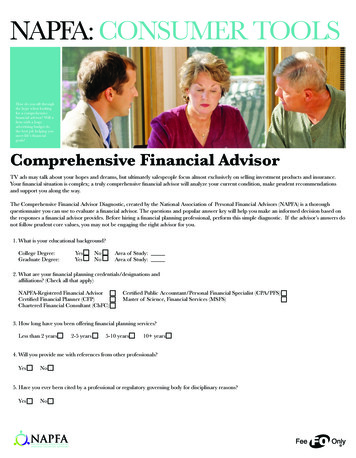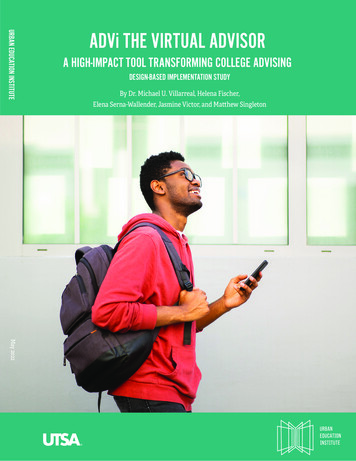
Transcription
1URBAN EDUCATION INSTITUTEADVi THE VIRTUAL ADVISORA HIGH-IMPACT TOOL TRANSFORMING COLLEGE ADVISINGDESIGN-BASED IMPLEMENTATION STUDYBy Dr. Michael U. Villarreal, Helena Fischer,Elena Serna-Wallender, Jasmine Victor, and Matthew SingletonMay 2022
2ABOUT THEURBAN EDUCATION INSTITUTEOUR MISSIONThe Urban Education Institute at UTSA produces scientific research to raise educationalattainment, advance economic mobility, and help people achieve their potential in thegreater San Antonio region.The Institute pursues its mission by (1) producing rigorous and actionable analysis thatsupports education policymaking, program implementation, and philanthropic giving;(2) convening community leaders to address entrenched challenges that harm educationand human development; and (3) training the next generation of social scientists andeducators to address education challenges through observation, analysis, and discovery.
3TABLE OF CONTENTSEXECUTIVE SUMMARY5KEY FINDINGS7RECOMMENDATIONS8INTRODUCTION10MEET THE USERS13DESIGN IMPLICATIONS18THEORY OF CHANGE19ADVI ADVISORS21RESEARCH DESIGN22FINDINGS27FIRST WAVE OF STUDENTS27SECOND WAVE OF STUDENTS44IMPLEMENTATION CHALLENGES49REFERENCES53APPENDIX A: ADVI USER ARCHETYPES54
4LIST OF EXHIBITSFIGURE 1High ADVi Reliance Archetype14FIGURE 2Medium ADVi Reliance Archetype15FIGURE 3Low ADVi Reliance Archetype16FIGURE 4Theories Of Implementation and Client Response20FIGURE 5Did ADVi Cause Students To Advance Their College Applications28FIGURE 6What Content Did Students Like The Most?30FIGURE 7Were There Any Topics That You Wished ADVi Covered Better?32FIGURE 8Students Who Knew They Could Use ADVi To Receive PersonalAttention From A Human Advisor35FIGURE 9Students Who Knew They Could Text Questions To ADVi Bot37FIGURE 10 Share Of Students Who Trusted ADVi38FIGURE 11Sources Of College-Going Advising41FIGURE 12Attitudes and Preferences Related To Help-Seeking48
5 5EXECUTIVE SUMMARYIn the fall of 2020, the Texas Higher Education Coordinating Board (THECB)entered a research partnership with the Urban Education Institute at TheUniversity of Texas at San Antonio (UEI), which was made possible by fundingfrom the Greater Texas Foundation (GTF). The THECB and GTF created thispartnership with the UEI to conduct collaborative, improvement-focusedresearch that would strengthen the ADVi Virtual Advising program (ADVi),a virtual college advising system that consists of an artificially intelligentchatbot and a human team of professionally trained college and careeradvisors. The arrival of ADVi and the three-year engagement with the UEIcould not have been timelier.Just as COVID-19 disrupted traditional sources of college advising, theTHECB launched ADVi. Their implementation of ADVi appears to havemade a significant impact and exceeded the expectations of its studentusers. By the end of its first year of operations, the THECB through ADVihelped 276,643 students complete their college application journey.
6During this successful start, the UEI research team began collectingdata on the ADVi user experience and its implementation. In this report,researchers summarize the findings that they have developed over thefirst two years of this three-year collaboration and offer recommendationsfor ADVi’s improvement. They have also produced two artifacts that areintended to drive ongoing conversations about systems improvement: (1)user architypes that capture the major clusters of student users and a (2)framework that identifies ADVi’s current theories of implementation andclient response.
7KEY FINDINGSADVi made a difference Students reported that ADVi helped themthrough the college application process. Theystated that they completed college applicationsteps because of ADVi’s timely reminders,next steps, and encouragement.All students who interacted with an ADViadvisor said their help met or surpassed theirexpectations. Students said that they would recommendADVi to friends. Students recounted that they needed themost help in completing a financial aidapplication and searching for scholarshipsand that ADVi helped them with these tasks. All students interviewed grew to trust ADVi’sinformation. Half of them said they wouldtrust ADVi more if their high school or futurecollege promoted it. The ADVi bot offered students a shame-freespace to ask any college-related question theyhad “without the risk of feeling dumb.”Student users clustered within one ofthree personas, or user archetypes Three personas generally represent the ADViuser population. They differ from each otherbased on their level of college knowledge andplanning and need for ADVi. Though ADVi currently makes the biggestdifference for the personas that need ADVithe most, these students need ADVi todo more because their college and careeradvising needs are much greater.Students needed ADVi instructions More than half of all students in the first waveof interviews did not know they could textwith an ADVi advisor or send questions to theADVi bot. None of the students interviewed in the firstwave knew about ADVi’s hashtag commands. Most students did not remember opting intoADVi, which made them skeptical of usingADVi for security reasons.ADVi filled a void during COVID Students described ADVi as filling a gap intheir college advising created by COVID-19.ADVi advisors improvisedoperational fixes ADVi advisors supported ADVi by playingmultiple roles aside from providingpersonalized advice for students. ADVi advisors conducted outreach to schools,helped develop temporary, manual processesfor tracking student requests for personalizedadvice, built a repository of answers tofrequently asked questions with supportinglinks and documentation, delegated workacross the advising team, and referredstudents seeking help with social emotionalchallenges to appropriate counselors.
8RECOMMENDATIONSTiming Improve the timing of informationcampaigns, which occasionally sentinformation to students after they needed it.Add info on scholarships and the collegegoing steps after being accepted to a college. Add content to help students navigate theirfirst year in college. Stop ADVi from sending more than one text ata time, especially during school hours. Add information for DACA students andstudents who are financially independent. Create a new way for students to opt-in orsign up for ADVi to reach those students whoneed help before starting their ApplyTexasapplication (where students currently opt-in)and as early as ninth grade. Regularly communicate definitions of collegegoing vocabulary terms, such as waitlist, twoyear college, four-year college. Continue to use prompts to help students whodon’t know what questions to ask.Personalization Experiment with sending messages of varyingcontent: infographics, videos, pictures,text-only, and text with links to determinewhich are most effective at spurring studentaction at different points in the college-goingprocess. Empower ADVi advisors to provide morepersonalized responses by allowing them tosee background information on students andwhere students are in the college applicationprocess. Deliver more personalized informationon scholarship opportunities and collegeprograms. Improve ADVi’s efficiency and ability to sendmore personalized information by havingit remember how students answered itsprevious questions.Consider expanding marketing efforts totarget students in 11th grade and eventually9th grade to help them become college-readybefore the application process. Make it easier for students to recommend andshare ADVi with friends.Content Experiment with adding office hoursfollowing the school day and into the earlyevening to allow students to talk to ADViadvisors by phone or video conference. Add information on preparing for theapplication process in 11th grade or as early as9th grade.New Features
9RECOMMENDATIONSCONTINUEDStaffing Improve staffing to ensure a consistentand adequate number of ADVi advisors arefocused on responding to students. Create a team of counselors who can providesocial-emotional counseling to students whoask for it through ADVi. Consider hiring support staff or additionaladvisors to handle tasks not directly related tocollege advising, such as school outreach. Improve the flow of information on ADVioperational needs to higher-level executivesto address issues as they ariseTrust & Engagement Invest in district- and school-level marketingand outreach to educate school staff aboutADVi and to have them promote ADVi as atrusted information source. Build a coalition of trusted partners (schooldistricts, colleges, nonprofit organizations)who will lend their names and logos for cobranding opportunities, including when ADVifirst introduces itself to students. Test micro-scripts generated from howstudents describe ADVi, such as “ADVi—your24/7 personal college and career advisor.” Improve student engagement with ADViby introducing it multiple times withinstructions and links to ADVi’s website andshort video tutorials. Send multiple reminders about ADVi’scommands and capabilities throughoutthe year, especially about the #followupcommand, which connects students to ADViadvisors.Back Office Processes Automate the system for tracking messagesfrom students to advisors. This system shouldalso automate assigning student questionsto advisors and tracking their resolution toreduce the chance of losing messages andincrease their responsiveness. Develop an interface that allows advisors tocommunicate back to students using a similartext messaging format rather than email. Provide photos or videos of ADVi advisorsto help students feel more comfortablecommunicating with ADVi advisors. Design message campaigns with ADViadvisors to improve the targeting and timingof campaigns. Test systems that are supposed toautomatically transfer student data to ADViat the start of each college application cycle orwhen these systems are updated.To help students reluctant to communicatewith ADVi advisors, reinforce the messagethat there are no dumb questions. ADVi is asafe place to ask questions. And ADVi advisorswant to hear from them.
1010INTRODUCTIONImproving access to higher education for all Texas students has longbeen a goal in our highly diverse state. Then came the COVID-19pandemic, which Commissioner Harrison Keller of the Texas HigherEducation Coordinating Board (THECB) has called “the most significantdisruption to higher education institutions since the end of the SecondWorld War.”Freshman enrollment in the country declined 13.1% in the fall of 2020compared with the previous year, while overall higher educationenrollment fell by 2.5% and two-year college enrollment fell by 10.1%during the same period (NSCRC, 2001).In Texas, college enrollment patterns followed a similar decline.Overall enrollment declined by about 2.1%, while two-year collegesexperienced a 10.3% drop (THECB, 2022a).
11High school students struggled as they learned remotely with limitedaccess to school-based college counselors. Many colleges closed inperson tours and operations. Fewer Texas students completed theFAFSA in fiscal year 2020, decreasing by 2.2% from 218,081 at the end ofAugust 2019 (USDOE, 2022). All these factors created even more urgencyto help students apply to college while keeping them safe from COVID.Fortunately, when the pandemic hit, the THECB was prototypingthe Virtual Advising Project (ADVi), which reaches students 24/7with “critical and timely information to support their postsecondaryjourney.” The ultimate goal of the project is to help more Texans “accesshigher education and complete their credentials at Texas colleges anduniversities” (THECB, 2021). ADVi, short for “advisor,” is a text-based,artificially intelligent chatbot that sends text messages about collegegoing information, suggests action steps students can take throughoutthe process, and responds to incoming questions from users. The ADVichatbot (or bot) can automatically answer many questions texted bystudents and connect them to ADVi advisors, a team of professionalcollege advisors, when questions cannot be addressed by the bot.ADVi started as a partnership with The University of Texas at Austinin 2019. It was then moved to the THECB and made available to allTexas students in the fall of 2020. During the 2020-21 academic year,most ADVi users opted-in to messaging from ADVi when they startedan ApplyTexas college application.
12The Urban Education Institute at The University of Texas at SanAntonio (UEI) established a research partnership with the THECB’sVirtual Advising team in the fall of 2020, thanks to generous fundingsupport from the Greater Texas Foundation. Over three years, theUEI team will collaborate with the THECB team to facilitate rigorouscontinuous improvement cycles to strengthen ADVi’s effectivenessand engagement with students.This research brief provides findings from the project’s first and secondwave of student interviews, which focused on getting feedback fromADVi student users about their user experience, their understandingof the college-going process, and access to resources outside of ADVi.It also provides findings from focus group interviews held with ADViadvisors to understand the strengths and challenges of implementationand identify areas of improvement.
1313MEET THE USERSIn design-based research, user archetypes, also referred to as personas,are created to spark a sense of empathy in the people who designprograms for the eventual users. With empathy, programs designershave been found to more effectively design programs to meet theneeds of their users.Researchers identified three user archetypes to schematically describethe population of potential ADVi users based on the qualitative researchfindings generated from student interviews. They also validated thepersonas by discussing them with ADVi advisors.Personas include Freddy (pg. 14), Manny (pg. 15), and Sara (pg. 16). Aside-by-side of these personas is available in Appendix A on page 54.Each of these personas has unique attributes and biographies. Butwhat primarily differentiates them is their level of reliance on ADVi tohelp them apply to college.
14FIGURE 1: HIGH ADVI RELIANCE ARCHETYPEMeet Freddy.“First-gen, High level of reliance on ADViADVi helped me complete my collegeapplications more than any person inmy life. I wish I had ADVi at the startof high school.”Freddy’s Goals Become a medical doctor Marry and have kids Own a home with a big yardFreddy’s Frustrations Not starting to plan for college untilmy junior year in high school Not being able to play on my highschool baseball team because I neededto workHigh School Academics Ranks in top 10% of graduating class Highest math credit was pre-calculus Completed an AP biology courseCollege Finances No family college savings Estimated family contribution 0 Estimated annual unmet need 13,500Freddy’s Experience with ADVi Does not remember signing up for ADVi ADVi was his primary source of info andadvice Would not have known about ADVi butfor starting an Apply Texas applicationwith the help of his favorite teacher Most of his questions were on FAFSAand finding strong pre-med programs He was happy to ask questions and seekhelp from ADVi advisors but neededprompts and remindersFreddy’s BioGraduated from SAISD’s BrackenridgeHS in 2020, where his favorite class wasbiology. Worked at a nursing home afterschool for 2 years of high school. He is theoldest of four siblings and will be first inhis family to graduate from high school.
15FIGURE 2: MEDIUM ADVI RELIANCE ARCHETYPEMeet Manny.Continuing-gen, Medium level of reliance on ADVi“ADVi helped me stay on track. It wasmy personal college advisor 24/7.”Manny’s GoalsManny’s Experience with ADVi Be a computer software developer Travel Help my familyManny’s Frustrations Not knowing which dual credit courses would transfer and advance me inmy degree program All the personal info needed forFAFSAHigh School Academics Ranks in top 10% of graduating class Highest math credit was AP CalculusAB Completed 2 AP & 2 dual credit coursesCollege Finances No family college savings Estimated family contribution 5,000 Estimated annual unmet need 8,500 Does not remember signing up for ADVi ADVi and high school counselor wereprimary sources of college-going help Connected to ADVi through ApplyTexas Mostly had FAFSA & scholarship questions Benefited greatly from reminders Was happy to ask questions of the ADVibot because it never made him feel likehis questions were dumb and it helpedhim prep for his meetings with his highschool counselorManny’s BioGraduated from NISD’s Clark HS in 2020,where his favorite class was a computerscience dual credit course at UTSA. Playedhigh school and club soccer and rancross-country. Raised by his single momwho earned a BS and MPA and serves as aprofessional in local government.
16FIGURE 3: LOW ADVI RELIANCE ARCHETYPEMeet Sara.“Continuing-gen, Low level of reliance on ADViI knew I was going to Texas A&M aslong as I can remember. It’s whereboth my parents went.”Sara’s Goals Earn a bachelor’s degree in businessfrom TAMU-College Station Start my own marketing businessSara’s Frustrations Wish I could start at College Stationmy freshman year instead of transferring from another school in the TAMUsystem Need help planning efficient transferHigh School Academics Ranks in top 25% of graduating class Highest math credit pre-calculus Completed 4 AP coursesCollege Finances 529 college savings Estimated family contribution 29,000 Estimated annual unmet need 0Sara’s Experience with ADVi Remembers signing up for ADVi basedon her brother’s suggestion. Asked questions of ADVi bot occasionally, mostly relied on high school counselorsand TAMU recruiters. Benefited from ADVi bot’s remindersand encouragements. ADVi was not an important source ofcollege info and advice.Sara’s BioGraduated from NEISD’s Reagan HS in2020, where here favorite experience wasleading the journalism club. She is theyoungest of two and hopes to join herbrother at TAMU-College Station, whereher parents first met at bonfire.
17FreddyFirst-gen, High level of reliance on ADViFreddy is the most reliant on ADVi of the threepersonas. As a first-generation college-goingstudent, he did not begin planning for college untilhis senior year when his favorite teacher beganasking him about his college plans. Freddy alsoattends a high school that has a below-averagesense of college-going culture, as seen by its belowaverage college enrollment rates.Freddy began using ADVi after his favorite teacherMannyFreddy benefited greatly from the ADVi bot andADVi advisors. He relied heavily on ADVi advisorsto help him and his mom complete his FAFSAapplication. He also used it to learn about collegeswith strong pre-med programs.Continuing-gen, Medium level of reliance on ADViManny relies on ADVi more than Sara but needsit less than Freddy. As a continuing-generationcollege-going student, he has received a lot ofadvice about preparing for college from his mom.He also attends a high school with a strong team ofcollege advisors and college-going culture.However, between his year-round, packed scheduleof athletic events and dual credit courses onthe campus of a local four-year college, Mannybenefited greatly from reminders sent by the ADViSarahounded him to start his ApplyTexas application.But for ApplyTexas and Freddy choosing to opt-into ADVi messaging, he would not have learned ofADVi at all.bot that kept him on track with his college andfinancial aid applications. He also appreciatedADVi’s words of encouragement, which made himthink of ADVi as a “cool mentor.”Like Freddy, Manny began using ADVi after hestarted his ApplyTexas application. The choice toopt-in to messaging in ApplyTexas was responsiblefor connecting Manny to ADVi. But for this feature,he would not have received the benefits of ADVi.Continuing-gen, Low level of reliance on ADViSara relied on ADVi the least as compared to Freddyand Manny. As a continuing-generation collegegoing student, her college plans were set as earlyas fourth grade. She has always planned to followin her parents’ footsteps by becoming an Aggie atTexas A&M—College Station. In fact, she had hopedto join her older brother who started his collegeeducation at TAMU two years earlier.Unfortunately, Sara did not qualify for automaticadmissions based on her class ranking and wasonly admitted under the TAMU System AdmissionsProgram, which meant she needed to start hercollege journey at a regional college of TAMUbefore having the opportunity to transfer toTAMU-College Station. Her parents and highschool counselors helped her begin researchingher options and planning her freshman year ofcoursework to minimize any loss of credit duringthe transfer process.Sara signed up for ADVi before starting herApplyTexas application on the advice of her olderbrother. What she liked most about ADVi were thereminders sent by the ADVi bot that kept her frommissing key college application deadlines. She alsowas grateful for ADVi’s encouraging words, thoughshe sometimes felt like she received too manymessages.
18DESIGN IMPLICATIONSHow can we improve Freddy’s ADVi experience?FreddyFirst-genHigh level of reliance on ADVi Use a preexisting process, such as school enrollment, or TSI ordual enrollment participation, to provide the option to enrollstudents into ADVi starting in ninth grade. Provide prompts to help students select their high schoolcourses and extracurricular experiences to support their collegeand career goals. Begin educating students about the ApplyTexas applicationprocess prior to senior year. Add more content about scholarship opportunities.How can we improve Manny’s ADVi experience?MannyContinuing-genMedium level of reliance on ADVi Use a preexisting process, such as school enrollment, or TSI ordual enrollment participation, to provide the option to enrollstudents into ADVi starting in ninth grade. Add content that helps students select dual credit and AdvancedPlacement courses that align with their college plans. Add more content about scholarship opportunities. Create ADVi training videos for high school counselors toencourage the integration of ADVi into their high-touch, schoolbased strategies.How can we improve Sara’s ADVi experience?SaraContinuing-genLow level of reliance on ADVi Add a feature that estimates a student’s class ranking startingin sophomore year so that there are no surprises at the time ofapplying to college. Add more detailed content to help students plan for efficienttransfers. Create ADVi training videos for high school counselors toencourage the integration of ADVi into their high-touch, schoolbased strategies.
1919THEORY OF CHANGEResearchers relied on ADVi advisors to develop a schematic frameworkthat describes ADVi’s theory of implementation and theory of clientresponse, as shown in figure 4 on page 20. A theory of implementationidentifies the essential activities that program operators willimplement in theory. A theory of client response identifies how clientsare expected to respond to programmatic activities in theory.Together, these theories are referred to as a theory of change. They helpidentify (1) where planned activities and client responses fail to meetexpectations, (2) where processes are underdeveloped, and (3) whereprocesses could be streamlined. Their development also benefittedfrom insights offered by students.
20FIGURE 4: THEORIES OF IMPLEMENTATION AND CLIENT RESPONSETheory of ImplementationTheory of Client ResponseTHECB markets ADVi to schools andstudentsSchools promote ADVi with their studentsADVi advisors conduct outreach to schoolsto promote the use of ADViApplyTexas application allows students toopt-in to ADViStudents start anApplyTexas application and choose toopt-in and enrol intoADViStudents text theword “COLLEGE” to512-829-3687Mainstay receives a batch of studentcontacts from ApplyTexas and feeds theminto ADViADVi bot begins sending messagesADVi bot sends student question orrequest to communicate with an ADViadvisor to a general email accountADVi advisors share the tasks of checkinggeneral email box, distributing queriesamong themselves, and logging queriesinto a tracking documentADVi advisors receive student queries intheir assigned folder, research answers toeach question, and respond by emailADVi advisorsupdate trackingdocumentSystem turns emailto text message andsends to studentStudents open and read ADVi messages,ask questions of ADVi bot, and take a stepin their postsecondary college and careerplanStudents ask ADVi bot to communicatewith an ADVi advisor by responding to aprompt sent by the ADVi bot or by texting#followup to the ADVi botStudents open and read message, askanother question for an ADVi advisor, andtake another step in their postsecondarycollege and career planStudents complete ApplyTexas application,financial aid applications, or another finalstep in their postsecondary college andcareer plan
21ADVI ADVISORSADVi’s theory of change begins at the top ofFigure 1, where the THECB markets ADVito students and schools. This activity is alsocomplemented by school outreach conductedby ADVi advisors. From these activities,schools promote ADVi to their students andstudents sign-up for ADVi.A major program activity is the design of theApplyTexas application to require students toopt-out of ADVi if they do not want to receiveADVi messages. This choice architecture allowsmany students to be included in the ADViprogram. However, before they begin receivingmessages from ADVi, a batch of student datamust be transferred to Mainstay and thenMainstay must input that information intoADVi. This process is expected to be largelyautomated.Once student contact data is entered intoADVi, the ADVi bot sends an introductorytext message to students. This messageexplains what ADVi is about and sharessome instructions. Following this message,the ADVi bot regularly sends messages tostudents. From these messages, students areexpected to become more informed about thecollege-going process, ask questions about theprocess to ADVi, take steps toward completingtheir college application and financial aidapplication, and grow in confidence about theirability to complete the college-going process.Students are regularly asked if they wouldlike a question of theirs to be escalated up toan ADVi advisor for answering. If they agreeto communicate with an ADVi advisor, theirquestion or concern is sent to a general emailbox overseen by the ADVi advisor team.ADVi advisors will review incoming messages,record them on a tracking document, anddistribute the questions into their assignedfolders. This is a shared set of tasks.ADVi advisors read their assigned studentqueries, research information to respond toeach query, and then draft a response to eachstudent by email. ADVi advisors then updatethe person managing the tracking documenton the status of each student query.The system turns the ADVi advisors’ email intoa text message and sends it to the appropriatestudent. From these ADVi advisor messages,students are expected to become moreinformed about the college-going process,ask more questions, take more steps towardcompleting their college application andfinancial aid application, and further grow inconfidence about their ability to complete thecollege-going process.ADVi advisors helped identify a few importantdistinctions between the ADVi bot’s servicesand those that ADVi advisors provide. TheADVi bot quickly answers a wide range ofcollege questions 24/7. In contrast, ADViadvisors take longer to respond but go deeperin searching for answers to questions that areunique to a student. The ADVi bot and ADViadvisors complement each other and serveas a one-stop-shop for answering students’complete list of college-going questions.With repeated questions answered, timelyreminders, and encouragement, studentsincrease their completion rate of collegeapplication and financial aid application,respectively.
2222RESEARCH DESIGNResearchers used a qualitative research design to understandthe implementation and user experience of ADVi and identifyopportunities for improvement. They conducted individual interviewswith 60 students who used ADVi. They also facilitated two rounds offocus group interviews with ADVi advisors. Researchers saved andtranscribed audio recordings for later analysis using Zoom, a videoconferencing application. During the first two years of the study,researchers met with THECB staff weekly or bi-monthly to coordinatedata gathering and share their emerging findings.Researchers shared their interpretations and then synthesized theirfindings into the first draft of this report. They then shared the firstdraft of the report with ADVi advisors and supporting staff for theirfeedback and to give them an additional opportunity to add to thereport. After reviewing the final round of staff feedback, researchersproduced this final report.
23Study SampleResearchers used a study sample of 60 students who used ADVi. Theyindividually interviewed these students in two waves. They alsointerviewed eight advisors during two focus group meetings.Wave One of Students. Thirty students comprised the first wave ofstudent interviews. These students where all located in Bexar Countyand intended to enroll in college in fall 2021. Twenty-eight were highschool seniors. One was a 2020 high school graduate who took a yearlong break from formal education. And one was looking to re-enrollin community college after taking time off to care for her family.Twenty-six students had already applied for college, and all but onehad received acceptance letters. The other four students were still inthe process of applying.Of the 30 students, 70% learned remotely during their senior year dueto COVID-19. Six, or 20%, were learning in a hybrid environment, somein person and some online remote learning. Only three participants, or10% of this w
process. Deliver more personalized information on scholarship opportunities and college programs. Improve ADVi's efficiency and ability to send more personalized information by having it remember how students answered its previous questions. Content Add information on preparing for the application process in 11th grade or as early as



